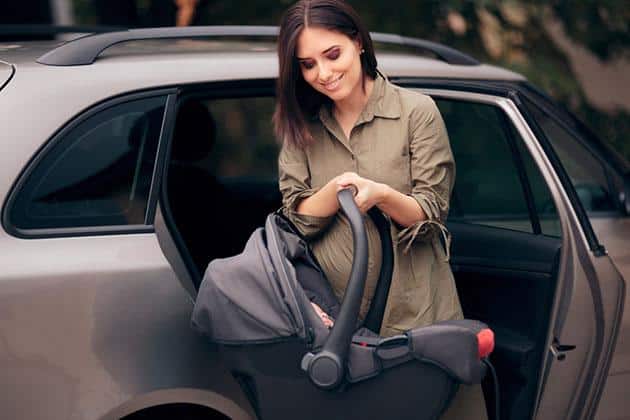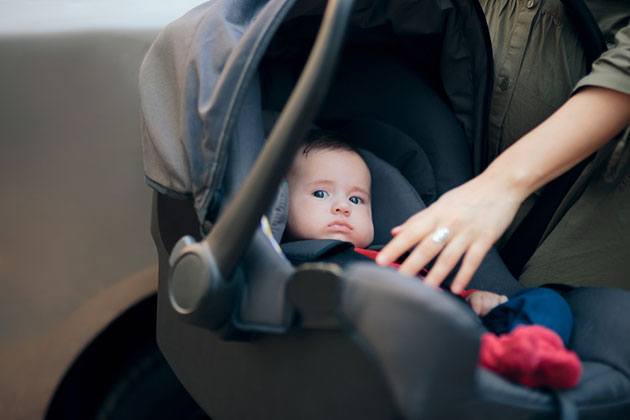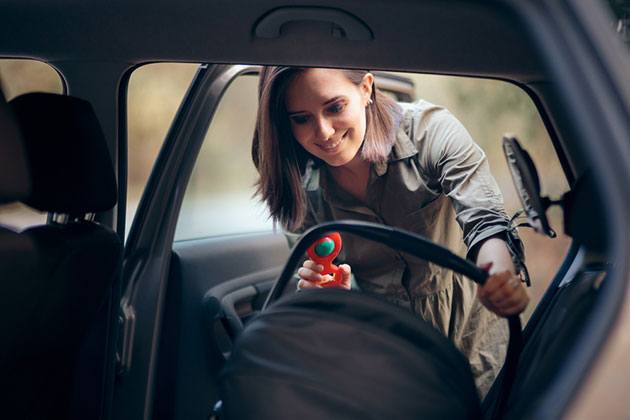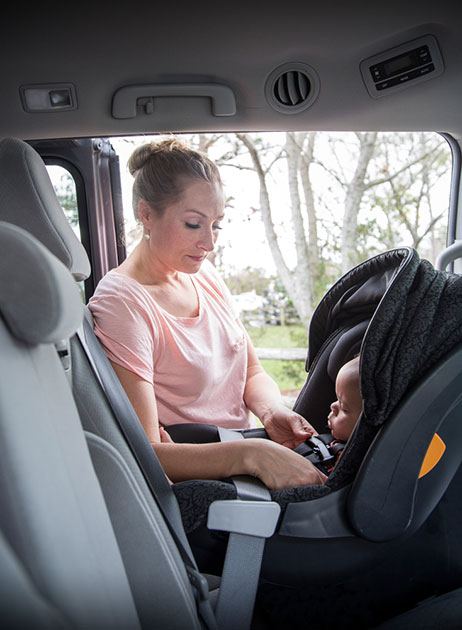First-time parents are often intimidated by how to put newborn in car seat safely and adequately. Upon hospital discharge, you should be prepared for proper car seat installation.
This step-by-step guide takes you through the entire infant car seat installation process, safety guidelines, and correct newborn fitting.
More...
How to Properly Install an Infant Car Seat?
Car seat manual 101
Infant car seats are only safe if installed correctly. Before installing the car seat yourself, check the infant car seat's instruction manual first. Not all car seats are installed in the same way. The car seat manual holds valuable information on adequate installation you need to follow for optimal car seat safety.
Many infant car seat manufacturers do not allow users to place positioner aids such as blankets or pool noodles around the car seat. Not only do inadequate positioners compromise the installation, but they will also not allow the car seat to perform well in a car crash.
Check for installation guidelines

Infant seats include a car seat base. Based on the car seat manual, the car seat base can be installed with one of the two installation methods:
With a vehicle's seat belt or lower latch anchors.
1. Vehicle seat belt installation
When installing the rear-facing car seats with a seat belt, check for the belt lock-off section in the car seat manual. Since every infant car seat works differently, there might be a different process for locking the belt.
Place the infant car seat in the back seat of the vehicle. Guide the vehicle seat belt through the rear-facing guide path. During the seat belt installation, ensure no twists and knots and the harness straps lie flat.
The infant car seat should not move more than one inch after it has been installed. Do the wiggle test, and check if there is any movement. Once the base is installed, you can attach the baby's car seat.
2. Lower LATCH installation
Before attempting to install the infant car seat with the latch system, locate the lower anchors in your vehicle first.
Once you have located your vehicle's lower anchors, connect them to the car seat base. Press the car seat base for a secure installation, and tighten the straps. As with seat belt installation, the car seat base should not have more than one inch of front-to-back or side-to-side movement.
Most infant car seats include a load leg for stability. When installing an infant seat with a load leg, drop the load leg down to meet the floor. The indicator on the seat should turn green so you can rest sure the installation is secure.
Adjust the harness & headrest
Before putting a newborn in the car seat, check if the harness and the headrest are appropriately adjusted. Refer to the car seat manufacturer manual for guidelines on the harness position.
The harness should be at the baby's shoulders in the rear-facing position. The bottom of the headrest should be aligned with the baby's ears. The child's head needs to be at least one inch below the top of the headrest.
Once you put the newborn in the infant seat, make further adjustments according to the baby's weight and height limit.
How Do You Know if You Installed the Infant Car Seat Correctly?
Side-to-side movement check
Installed car seats should not move more than one inch (2.5 cm) from side to side and front to back. The movement check should be conducted after each installation, either the seat belt or the latch system.
Remember that a child's car seat offers more movement at the top than at the bottom. If you are still unsure whether you have installed the car seat correctly, find a local car seat inspection station. The station will recommend a Child Passenger Safety Technician who will help with installation.

Level indicators
Most car seats, including an infant seat, include level indicators. The level indicators assist you in knowing whether you have achieved a correct angle installation or not. The angle indicators are beneficial for newborns when adjusting the recline angle.
Fitting the Newborn in Car Seat Correctly: Step by Step
1. Move away the straps
Before putting a baby in a car seat, unbuckle and move the harness straps to the sides. Moving the harness straps away makes it much easier to put the newborn in without the straps getting trapped underneath the baby.
2. Gently put the baby in the car seat
Hold the newborn with one hand under the back and bottom while your other hand supports the neck and head. The baby should be in the center of the infant car seat, never slouched down or too high up. The baby's bottom must be as far back as the rear-facing car seat.
3. Adjust the harness straps
Grab the harness and shoulder straps from the sides. Gently take the baby's arm and put it through one shoulder strap. Do the same with the other arm. Make sure the shoulder straps are not distorted. After you have adjusted the shoulder straps, they should be at or below the baby's shoulder level.
4. Adjust the crotch buckle & chest clip
Slide the chest buckle to the center of the baby's body. The chest clip must be in the middle of the child's chest, never near the belly button or neck.
Click the chest clip with the crotch buckle and straighten any possible twists. The crotch strap should be as near to the baby's body as possible to prevent baby slouching.
Pull the adjuster strap on the bottom of the infant car seats to get the straps snug.
5. Check for tightness
Once all the harness straps are connected and adjusted, it's time to check for tightness. The tightness is best checked with a "pinch test" or "two-finger test." The fitting is loose if you can pinch the harness's excess webbing or slide more than one finger under the harness.
In case of an improper fitting, repeat the adjustments to ensure the baby is buckled snugly in their car seat. A loose harness is a safety hazard. A baby can be a projectile in a frontal crash if not buckled in appropriately.
6. Position the head
Although newborns can nap in their car seat during the ride, the baby must keep the proper head position. Newborns usually turn their heads to the side during the nap, which is considered a natural sleeping position.
However, it's not rare to see a newborn's head flop forward. So if your baby slouches forward, this is a position you must correct!
Newborns at six months old cannot still keep their heads straight, not only in car seats but in bouncy chairs, cribs, and the swing. The slumping of the head to the chest could block the airways.
7. Recline the seat
An infant car seat can reach multiple positions. As we mentioned, car seats come with an angle indicator, although their design may vary. For example, some indicators are in the form of a bubble, while some have a line design.
A rear-facing position must allow the newborn to ride in a semi-upright position at a 45-degree angle. A semi-reclined position will allow the newborn to breathe properly without any airway restrictions.
If the rear-facing car seat does not allow for this recline, contact the car seat's manufacturer or read the instruction manual for such information. A few car seat manufacturers will allow parents to use a rolled-up towel or a pool noodle under the car seat to reach a proper recline.
Tips on Newborn Car Seat Safety
1. Avoid bulky clothing

Cold weather can challenge parents, as most do not resist the urge to dress the newborn in bulky clothing. However, the thick padding and coats should be avoided when putting the newborn in a car seat. Bulky clothes can often interfere with proper harnessing and pose a safety hazard.
Before you buckle your newborn in, double-check whether the clothes he is wearing are not compressing with the harness. If you are worried about your little one getting cold in the car, put a blanket over them, but only after harnessing the baby.
Make sure the blanket is not close to the child's head and does not get loose.
2. Beware of positioner aids
Positioner aids are great if you have a small newborn or a preemie. However, aftermarket positions are to be avoided at all costs!
If you do use positioners like head padding, pool noodles, or body pillows, only use those that came with the baby's car seat. Aftermarket positioners have not been tested with your car seat and, therefore, will not perform well under a collision. Instead of protecting the baby, aftermarket products will do the opposite.
3. Avoid a used car seat
Used car seats are not forbidden from use. However, you need to check the car seat history first. If you are purchasing a used car seat, make sure it has not been in a crash, it's not damaged or recalled.
4. Limit car rides & seat use
Newborns should not be in a car seat for more than 60-90 minutes. If you have a long ride ahead, take frequent pit stops to take the baby out of the seat.
After you arrive home, take the newborn out of the car seat and put them in a crib or bassinet. Newborns should not be sleeping in a car seat, as seats are not designed for that purpose.
5. Keep the toys away from the handle
Hanging toys from the car seat handle can be entertaining for long rides, but they can also be a projectile in a crash. Avoid using these types of toys, especially if they are heavier.
FAQs
Can you put a newborn baby in a car seat?
A newborn baby can use a car seat only if they meet the height and weight limits of the rear-facing seat. Newborn babies should ride in a semi-reclined position, with a five-point harness adequately adjusted.
What is the safest place for a newborn car seat?
The safest place for a newborn car seat is the center back seat. In the middle seat, the newborn is away from airbags and protected from side crashes.
We recommend reading the manufacturer's instructions before installing the infant seat in the center rear seat. As many newborn seats include a car seat base, some vehicles do not have middle lower anchors for latch installation.
The newborn should never be in the front seat, next to the driver!
How long can a newborn sit in a car?

A newborn baby should sit in a car for 60-90 minutes. Any ride longer than 90 minutes requires you to frequently stop and take the baby out of the car seat.
Do I need a newborn insert for a car seat?
A newborn insert is not necessarily required for a car seat if you have a bigger newborn. A newborn insert is cushioned to support the newborn's body in an infant car seat until the baby reaches 15 pounds.
Never use an aftermarket newborn insert, as it can compromise the baby's safety.
Can you travel by car with a 2-week-old baby?
Traveling by car with a 2-week-old baby is advised only for short-distance trips. A newborn should not be in a car seat for longer than two hours. If you plan a longer trip, ensure you do it when the baby's immune system fully develops at around three months.
The newborn has outgrown the car seat. Now what?
After the newborn has outgrown the infant car seat, the best practice is to continue with rear-facing convertible seats.
The infant car seats can support newborns up to 35 lbs; however, after the baby exceeds this limit, it's time to transition to a convertible.
Convertible car seats offer a bigger rear-facing weight and height limit, allowing your newborn to stay in the safest position for longer.
In addition, a convertible seat can be used as a forward-facing car seat position or even a booster seat, depending on the model you pick out.
Final Words
Putting a newborn in a car seat should be done with care and precaution. We hope this guide will prepare you better for newborn car seat safety once you welcome your little one into the world.
Remember, a car seat is essential, but it's only considered safe if installed properly!
